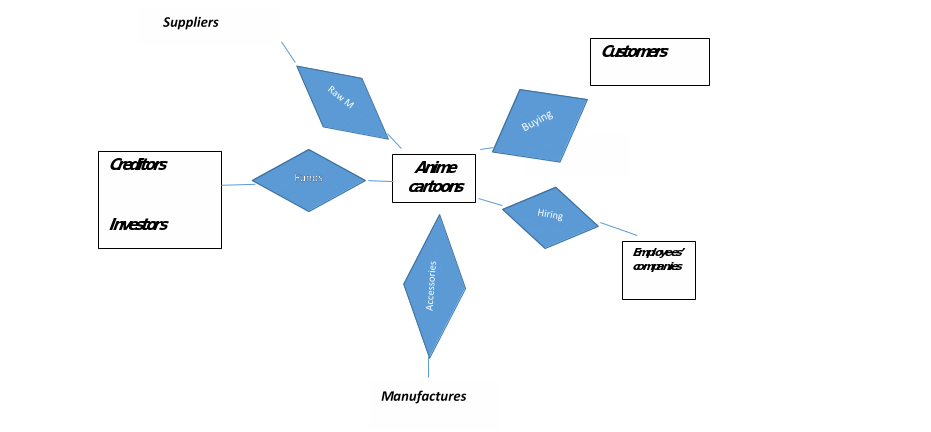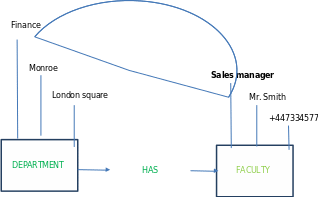The paper is meant to discuss the components of the Anime Makers enterprise system meant to handle the following tasks:
- Procurement of raw materials
- Acquiring and selling accessories
- Financial monitoring such as creditor information and hiring employees
Ideally, the enterprise system automates repetitive functions by consolidating them for easier management and decision-making. Each function, as shall be illustrated in this paper are related through the conceptual model of notation that help the management and other stakeholders visualize the cash in-flows and outflows, and the corresponding activities emanating from such activities, either through consuming or producing the resources (Javed & Lin 2018). While various conceptual designs exist for structuring the enterprise system, the current project shall use the Chen conceptual model to illustrate the automation of Anime Makers’ repetitive functions. According to van de Put et al. (2018), the Chen conceptual notation provides a clearer visual representation of system diagrams used in automating otherwise complex relationships.
Purpose of using the Value Systems Level Model
Value systems play a significant role in influencing the behavior of the network members. While the purpose of the value systems is varied, they describe the link of activities among firms, their suppliers, distribution channels, business associates, and the intended customers. In this regard, the value system shall provide a visual representation of how Anime Makers attach value to various aspects of their internal and external activities. If structured, the conceptual data model highlights the content and implication of convoluted information into the relevant context for the stakeholders. The listed activities relate the organization to; the suppliers, investors, creditors, customers and employment companies tasked with hiring workers associated with its business activities.
Ideally, the conceptual framework in figure 1 contain five set entries that are linked to the Amine Cartoon Company. The set activities (displayed in the rectangles) represents the corporate entities, partners or business organizations that the Anime Company deals with. Conversely, the diamonds illustrate the relationships that exist between the entities of the first class sets (van de Put et al., 2018). The lines drawn between indicate the participation of the entities within a given set.

From figure 1, the company the manufacturers provide the necessary raw materials for the company’s production process. The conversation occurs within the company, with the input of the employees and laborers hired at various production levels. Also, the conceptual models indicate that the cash inflows into the company come from sales made to customers, creditors, and the investors. Non-cash inflows into the company include labor and raw materials from the manufacturers. The company partners identified by the model include; the suppliers, manufacturers, and creditors.
How Many Income Channels Exist for this Company?
The conceptual diagram indicates that the company has three major distinct channels of income: commission from sales of accessories from manufactures, revenue from in-house production and possible income on investment. Ideally, the company buys ready-made accessories from other manufacturers and sells them at a profit to their potential customers. Equally, such sales could generate commission from sales made on behalf of the accessories manufacturers, thus becoming another potential source of income. Additionally, Anime Cartoons procures raw materials such as caps, stickers, and t-shirts and processes them into complete products. Sales made from the finished products, either directly to customers or through other suppliers, become a potential source of income. As aforementioned, Anime Cartoons has several investors.. From the capital investment, the company could generate income in a plethora of ways. For one, investments could be channeled towards stock investment to generate dividends usually, classified as investment income. According to the study of Triani and Tarmidim (2019), shareholders could decide to either distribute total shares for a financial period or retain them as a source of corporate funding. When this happens, it becomes a source of earnings for the company. More significant investments could become a potential avenue to increase production and generally expand the business. When this happens, the stock becomes an indirect avenue through which the business increases its income.
Draw the Complete Value Chain Level Model for Anime Makers? List all Business Processes and their Inflow/Outflow Resources

From the model in figure 2 the creditors and the investors relate to the business through finances. Through the financial input of the creditors and the investors, the business can buy the required raw materials and print the Anime Cartoons into finished products before generating revenue through sales. Equally, the customers play a significant role in generating revenue through purchases. It is from the end-users that the company generates revenues from both the rebranded products and the accessories acquired from other manufacturers.
Conversely, the conceptual notation shows a plethora of two-way flows of cash. For example, the investors put in their resources through capital and receive back through dividends. On their part, creditors provide financial services invested in the company operations and receive back through interests. Non-financial in-bound flows include the provision of laborers paid through the employee companies and the supplies who sell the raw materials for the company. Out-bound non-financial flows include finished products like the printed t-shirts, stickers and caps as well as the accessories bought for resale. While customers receive the finished products from the company, they give back revenue through purchases of the products.
Entity-Relationship Diagram

From the table, the finance department relates to the faculty of financial management in many ways. For one, through the faculties such as sales management, the finance department can raise the required revenue to run core functions of the business. For example, procurement of raw materials, payment of employee companies for the labor services ordered, among other aspects related to the finance department. Ideally, the flow of resources within the system indicates the systematic transfer of resources (financial or otherwise) from one production level to the other. Also, the system shows the flow of responsibility from one department to the other. For example, at the procurement level, the finance department, through the faculty of related professionals, buys the raw materials for conversion into complete products. The responsibility is passed on to the production department for the printing of the Anime Cartoons. The sales department then assumes the responsibility of ensuring that the products reach the end-users. Revenues generated from the sales are regenerated into the system through the finance department. Other departments, such as the human resource, join the system through payment and management of the employees’ payments. In sum, the concept system displays a series of interrelated transfers of both cash and resources.
References
Javed, M., & Lin, Y. (2018, March). Iterative Process for Generating ER Diagram from Unrestricted Requirements. In ENASE (pp. 192-204).
Triani, N., & Tarmidi, D. (2019). Firm value: impact of investment decisions, funding decisions and dividend policies. International Journal of Academic Research in Accounting, Finance and Management Sciences, 9(2), 158-163.
Van de Put, B., Vaandrager, F. W., & Achten, P. (2018). Scoring Entity-Relationship Diagrams Drawn by a Computer Algorithm.